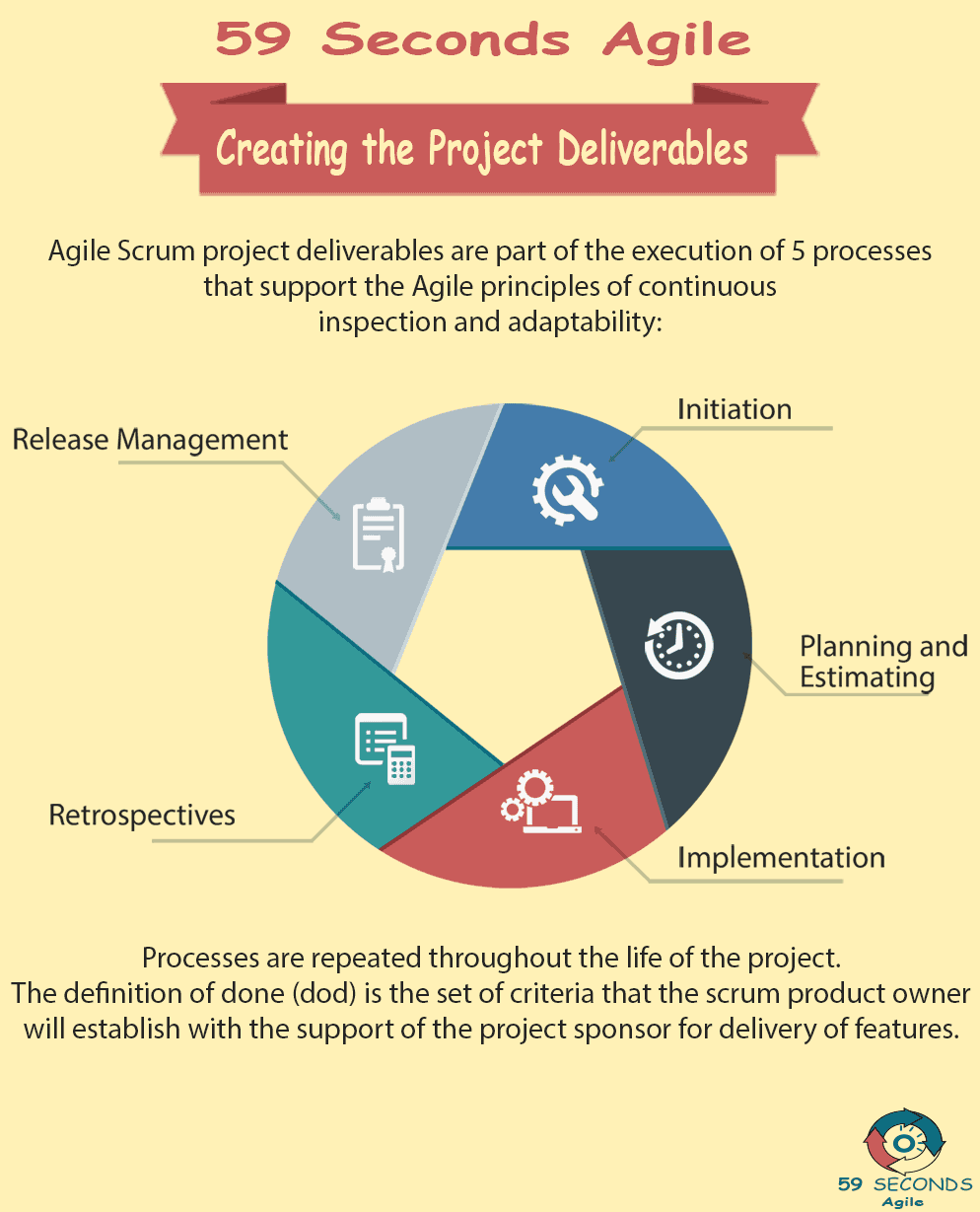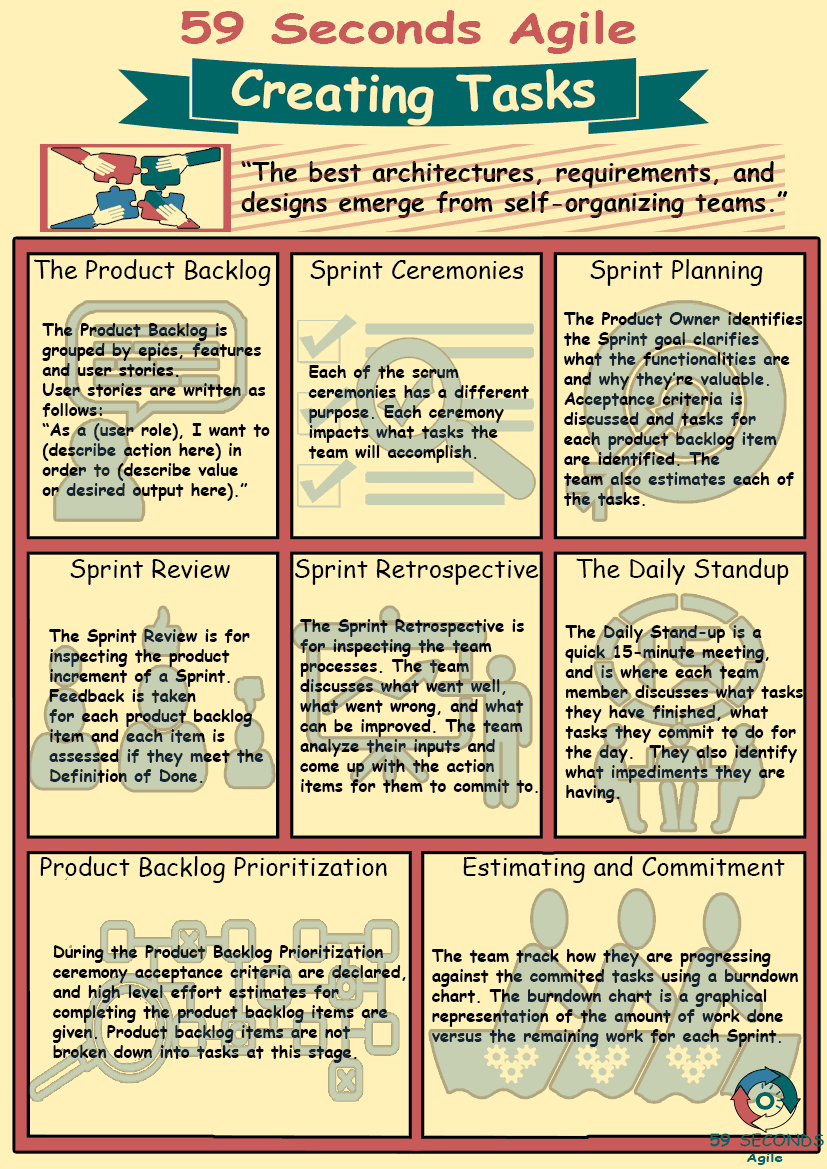This article looks to discuss ‘Agile Deliverables: Creating the Project Deliverables’. It provides an introduction to creating the Agile Project deliverables with respect to the Scrum Master role.
Agile User Stories and Tasks
A 59 Seconds Agile Training Video
Continue to Part 2 Below
Creating the Project Deliverables for Scrum Masters
A 59 Seconds Agile Article
Agile Scrum provides the framework for delivery of the vision of an organization. Execution of the vision includes processes, ceremonies and project deliverables that are also known as artifacts. Agile Scrum project deliverables are part of the execution of 5 processes. These processes support the Agile principles of continuous inspection and adaptability:
- Initiation
- Planning and Estimating
- Implementation
- Retrospectives and
- Release Management.
It is important to note that these processes are not linear in nature (similar to that of a waterfall project). They are repeated throughout the life of the project to complete the Definition of Done (DoD). The Definition of Done (DoD) is the set of criteria that the scrum product owner will establish with the support of the project sponsor for delivery of features.

Agile Deliverables: Creating the Project Deliverables and the Scrum Master
The Scrum Master – as part of the overall scrum team – has responsibility for guidance in the creation and management of deliverables and adherence to processes and ceremonies where the deliverables are created. With a few exceptions, the Scrum Master is generally not responsible for the actual creation of deliverables. Deliverables and artifacts are closely facilitated by the Scrum Master in order to meet the overall objectives of a project.

Agile Deliverables: Initiation
Projects are developed from a current need or future perceived need for a group of end-users. Agile scrum projects will create a project vision statement as part of the north-star that scrum teams, stakeholders, and end-users can refer to during the life of a project.
Agile Deliverables: Collaboration
Teams that support the collaborative nature of Agile Scrum will take the initial vision that a project sponsor provides and develop a project vision statement. The vision statement should be clear and concise outlining the objectives and market need that will lead to a specific set of outcomes. The scrum master’s role is to provide feedback on the vision statement to ensure that there is a vivid understanding of the requested product. This knowledge and the ability to go back to the vision statement during sprint execution are important to support the scrum team in understanding the objectives and customer needs that are being developed.
Our Favourite Agile Books
We found these books great for finding out more information on Agile Scrum:
Agile Deliverables: Planning and Estimation
The planning and estimation portion of the project creates artifacts that will be utilized throughout the life of the product development. The prioritized product backlog, user stories with estimates and a risk register are deliverables created during this phase.
Prioritized Product Backlog – the product owner has responsibility for the definition of the features that will make up the product backlog at the epic level. The scrum master will facilitate the engagement of scrum team members and support the product owner in the definition and management of the backlog. High-level estimates and priorities are established against the backlog features. The scrum master will ensure that dependencies are also reviewed during this ceremony. The goal is to reduce technical debt and additional features may be identified as a result of the review.
Agile Deliverables: Creating the Project Deliverables & User Stories
User Stories – all members of the scrum team – product owner, scrum master and scrum team members – participate in the development of user stories. The stories must be detailed enough so that specific tasks can be assigned to each user story. Estimates will also be refined during this time. The scrum master will facilitate the development of user stories to validate the prioritization, identify additional dependencies and verify the creation of acceptance criteria that meet the Definition of Done.
Prev <— Continue Reading —> Next
The Agile User Stories and Tasks
A 59 Seconds Agile Video Animation
Prev <— Continue Reading —> Next
User Stories Applied
A 59 Seconds Agile Book Review
User Stories Applied by Mike Cohn is one of our favourite books on Agile User Stories. The book starts with an overview into user stories, and details what a user story is and the different aspects of them. He then discusses how to go about writing a user story, and provides details of the INVEST criteria that can be used to determine if the story is meeting all of its objectives. Next Mike gives an in depth discussion of who user stories are written for and where to begin when gathering the details for them. The book then discusses acceptance testing user stories, including how to go about specifying these criteria and the responsibilities of the development team and customers during this process.
Prev <— Continue Reading —> Next
The Agile Frameworks
A 59 Seconds Agile Infographic

Prev <— Continue Reading —> Next
User Stories Applied
A 59 Seconds Agile Book Review
User Stories Applied by Mike Cohn is one of our favourite books on Agile User Stories. The book starts with an overview into user stories, and details what a user story is and the different aspects of them. He then discusses how to go about writing a user story, and provides details of the INVEST criteria that can be used to determine if the story is meeting all of its objectives. Next Mike gives an in depth discussion of who user stories are written for and where to begin when gathering the details for them. The book then discusses acceptance testing user stories, including how to go about specifying these criteria and the responsibilities of the development team and customers during this process.

